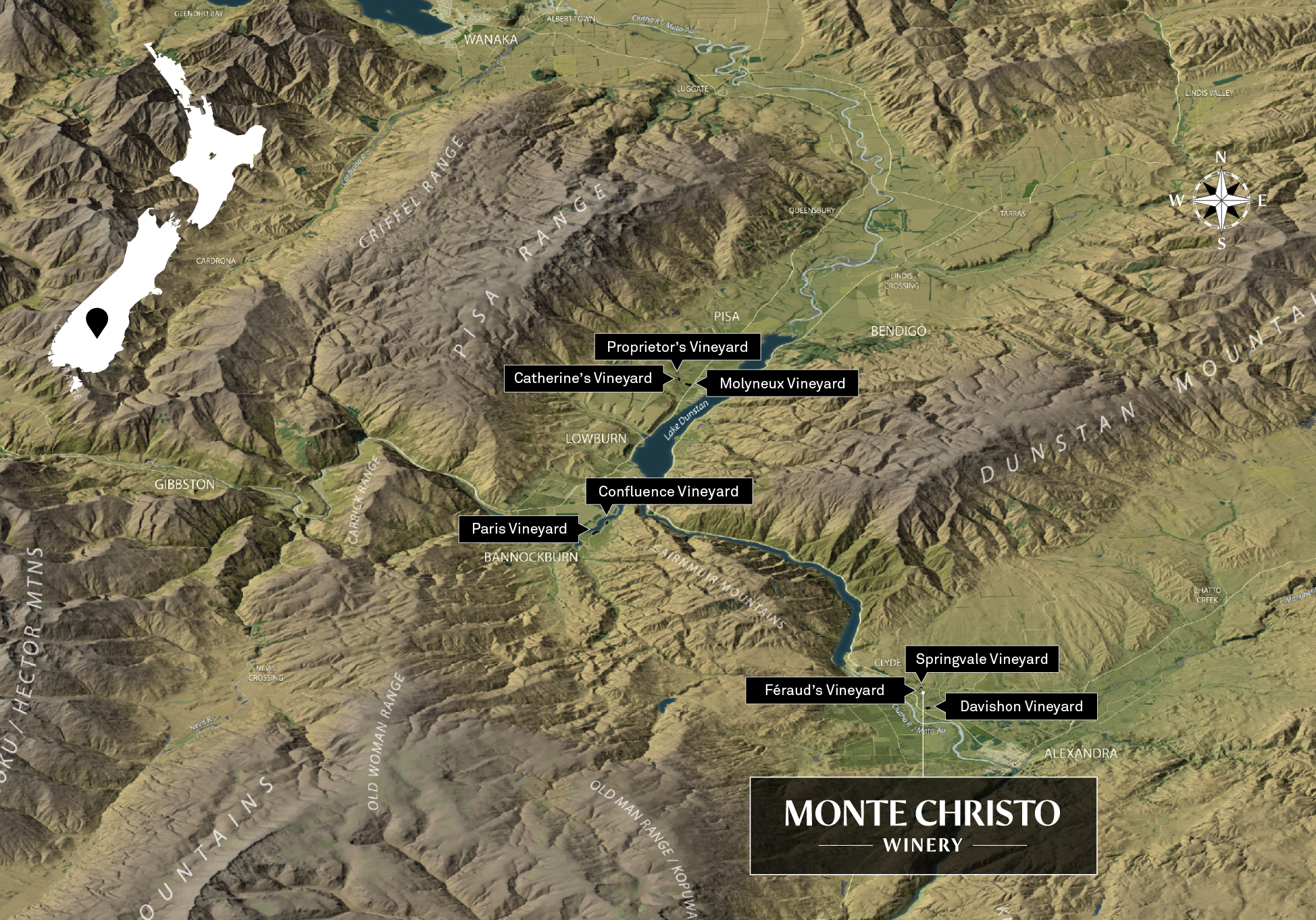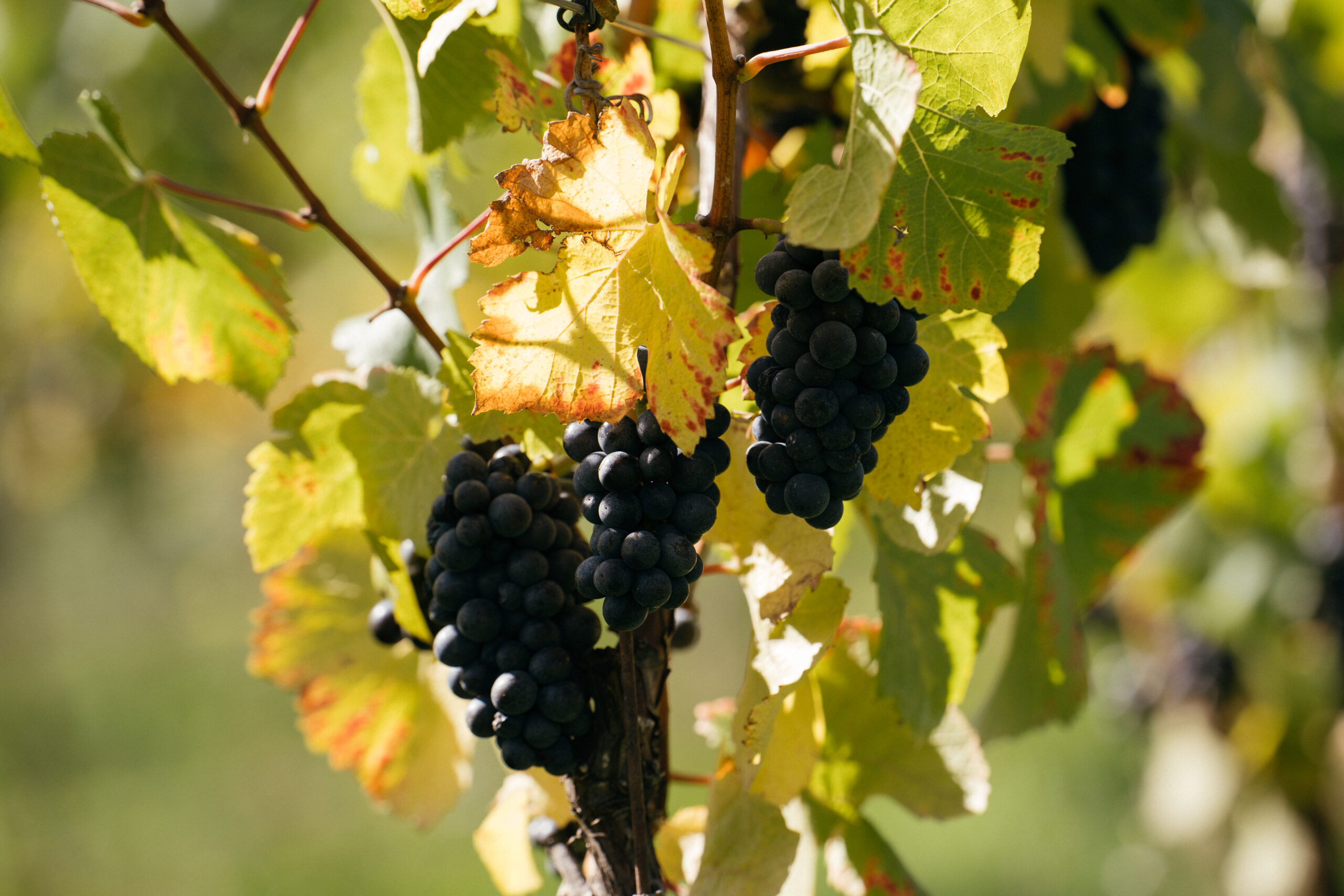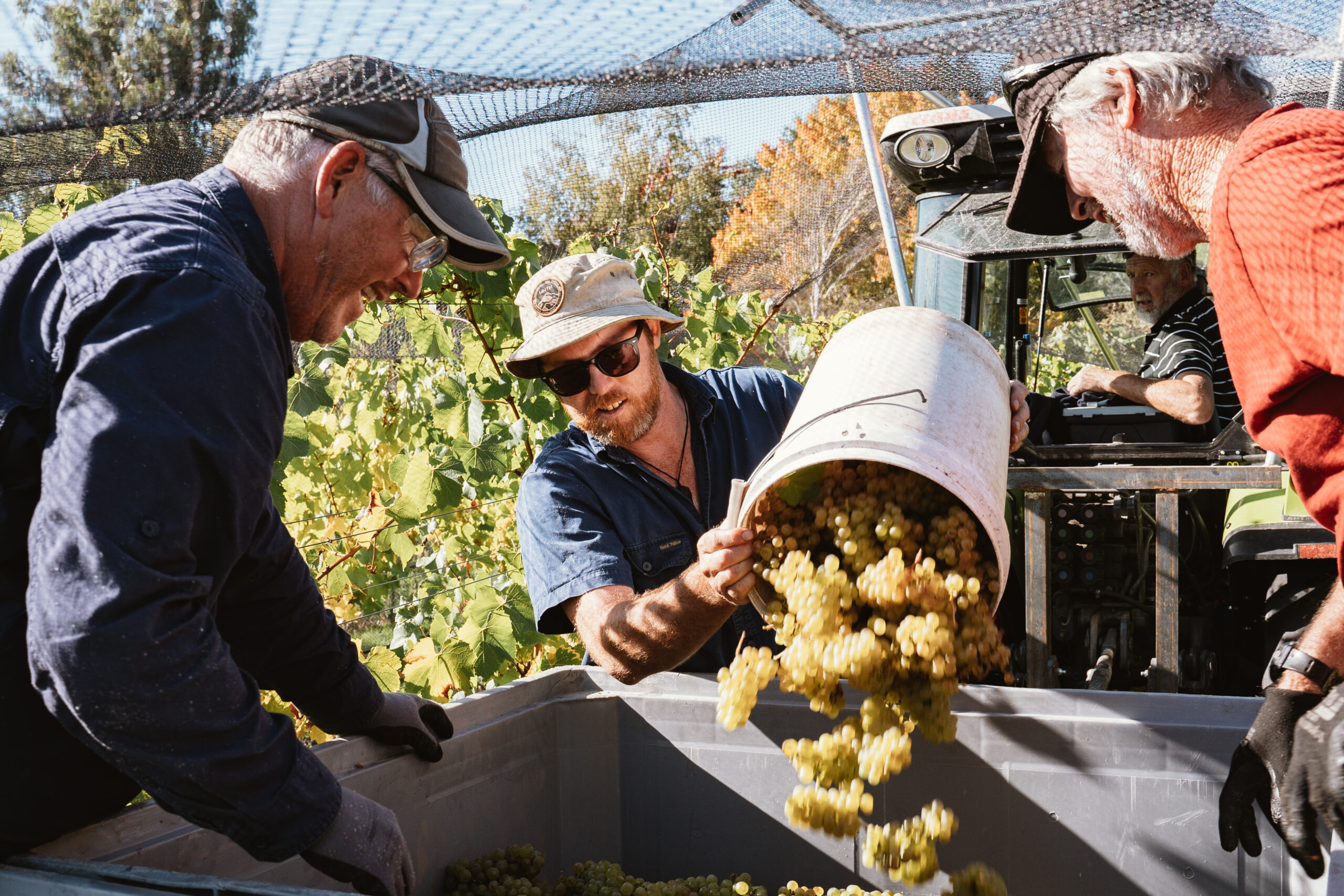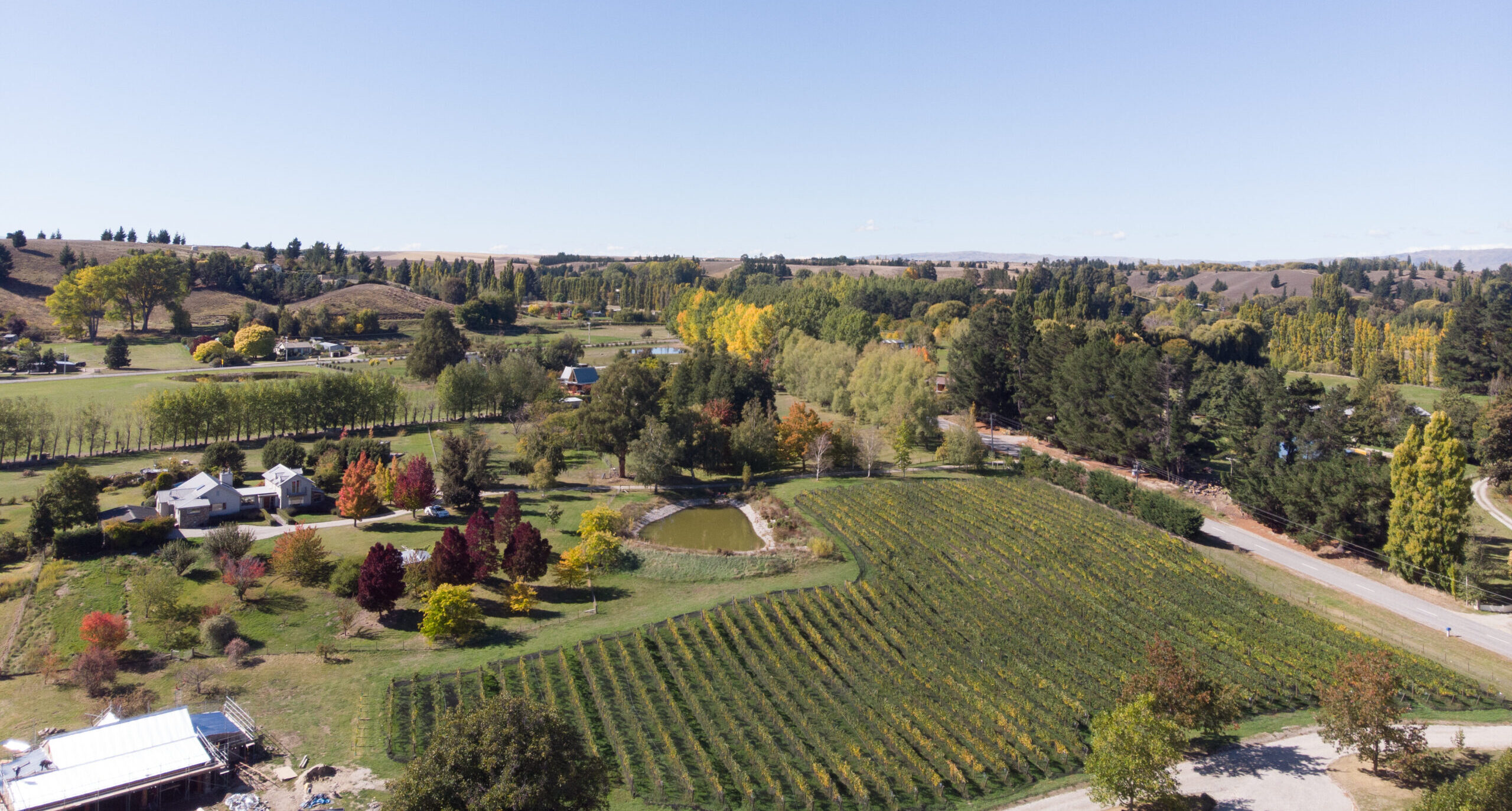
The Alexandra Basin is home to a diverse collection of vineyards stretching across Clyde, Letts Gully, Alexandra, and Earnscleugh. It is New Zealand’s southernmost wine-growing region, and has a notably dry climate with extreme temperatures in both summer and winter and large diurnal temperature ranges throughout the year. Although the area can record some of the highest temperatures in summer, early spring frost is a constant concern and, overall, it has the lowest seasonal heat accumulation of the subregions with which we work.
The Davishon Vineyard is located on Airport Road near Alexandra, not far from the Clutha River. The vineyard was planted in 1994 with a mix of Pinot Noir, Chardonnay, and Pinot Gris. A slightly unusual training system is used in this vineyard – called a modified Geneva Double Curtain – where the vines are spur pruned and left to sprawl in a downward fashion with no support from any wires. This shades the fruit nicely but means the grapes can be susceptible to wind damage. The vineyard was put into BioGro conversion in 2023.
Located on the original site of Jean Désiré Féraud’s property near Clyde, the vineyard is adjacent to our Cellar Door. The block was planted in 2019 with Pinot Noir, Chardonnay, and Pinot Gris, and became organically certified with BioGro in 2025.
A stone’s throw from Féraud’s Vineyard, the Springvale Vineyard is located northwest of the Cellar Door next to Springvale Road and is planted exclusively with Pinot Noir. This vineyard was planted in 2019 and became organically certified with BioGro in 2025.
The Bannockburn subregion, now formally registered as a Geographical Indication, is considered the premier wine-growing area in Central Otago. It is situated on the south bank of the Kawarau River at the southern end of the Cromwell Basin. With close proximity to the river, and the shelter of the surrounding mountains, the area maintains very consistent growing seasons.
Bannockburn is divided into two distinct parts; Felton Road and surrounds to the west, and Cairnmuir Road/Cornish Point to the east. Between these areas are a huge range of soil types from deep sun-baked clays, to schist-based loams and sandy wind-blown deposits. In turn, the wines from this area are very complex and distinctive.
The Confluence Vineyard is located on Cornish Point Road, on the southern shore of the Kawarau River. It is only 700m northeast of the Paris vineyard and is under BioGro conversion as of 2023. It is 100% Pinot Noir.
The Paris Vineyard is located in Cairnmuir, on the southern shore of the Kawarau River. The 6.6-ha vineyard was planted in 1999 with Pinot Noir and Pinot Gris. In 2022, the vineyard became organically certified with BioGro.
The Proprietor’s Vineyard is a small block of Riesling planted on a steep sun-drenched slope above Catherine’s Vineyard. With all day sun it is relatively exposed to the elements, but the deep glacial soils allow for the vines to thrive. In 2025, the vineyard became organically certified with BioGro.
Located on a plateau above the valley floor, the vineyard gently slopes to the east and is relatively frost-free. The soil is quite varied across the vineyard, contributing to different growth patterns, and it tends to be one of our earliest vineyards to be harvested. Planted 100% with Pinot Noir, there is a mix of different rootstocks and clones, providing interesting flavour profiles. In 2025, the vineyard became organically certified with BioGro.
The Molyneux Vineyard is located on the valley floor below Catherine’s and Proprietor’s Vineyards. A flat, relatively warm site, it is made up of 70% Pinot Noir and 30% Chardonnay. The soils are composed of deep, homogenous gravels with a few silt lenses. The vineyard was put into BioGro conversion in early 2024.

Organics is a vital part of our farming practices. Our Paris Vineyard was certified organic with BioGro in 2022 and our other vineyards are well on their way to achieving the same credentials. In addition, all our vineyards are certified with Sustainable Winegrowing New Zealand (SWNZ).
We only use organic sprays on our vines; no herbicides or pesticides are applied. Powdery Mildew and Botrytis are some of the biggest threats to crop quality, but with our warm, dry climate and careful vineyard management we are able to keep these risks at bay.
We have also introduced regenerative viticulture with the use of cover crops, animal grazing and a no-till system where possible. These practices help to increase soil organic matter and improve moisture retention, along with enhancing biodiversity in plant species as well as the insects they attract.

The growing season in Central Otago starts in early October with bud burst, followed by flowering in December and harvest in March and April.
Another threat we face here in Central Otago is early-season frost which can damage the tender shoots in early spring. To combat this, we use a mixture of frost fans and water sprinklers.
In late spring, the vines are shoot thinned and supported with wires, predominantly in a VSP (Vertical Shoot Position) system, apart from Davishon which is trained on GDC (Geneva Double Curtain). If the flowering has been good, we may need to adjust the crop with some selective bunch thinning. To keep the grapes safe from birds, we use deterrent lasers and apply nets over the vines.
All our fruit is hand-picked and gently sorted, and then carefully transported and delivered to the winery for processing.

Here at the 45th parallel, we enjoy long daylight hours in summer, and our continental climate provides a notable diurnal temperature range. This effect helps to extend the growing season, slowing down ripening, preserving grape acidity, and allowing sugars and flavours to develop gradually, which result in elegant, refined wines.
Subscribe to our mailing list and be among the first to receive the latest news, celebrate our newest wine releases, and secure your invitation to unforgettable events that only happen here – sign up now!
Looking for a cosy winter getaway?
Come stay with us & unwind in true Central Otago style.
Book direct on our website and enjoy a complimentary breakfast & wine tasting! 🍷
Age Verification
Please verify you are of legal drinking age in your country of residence.